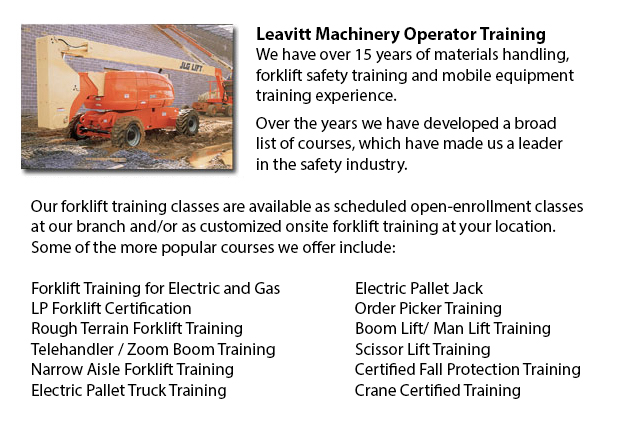
Kingston Boom Lift Certification - Elevated work platforms allow work and maintenance operations to be performed at heights that can not be reached by whichever other way. Boom Lift Certification Training teaches workers regarding the safe operation of boom lifts and scissor lifts.
Despite the range in lift style, site conditions and applications, all lifts have the possibility for serious injury or death when operated unsafely. Electrocution, falls, crushed body parts, and tip-overs could be the unfortunate result of wrong operating procedures.
To be able to prevent aerial lift accidents, people must be qualified in order to train workers in the operation of the specific kind of aerial lift they would be making use of. Controls must be easily accessible beside or in the platform of boom lifts used for carrying workers. Aerial lifts must not be be altered without the express permission of other recognized entity or the manufacturer. If you are leasing a lift, ensure that it is correctly maintained. Before utilizing, controls and safety devices have to be inspected to ensure they are properly working.
Operational safety procedures are vital in avoiding incidents. Operators should not drive an aerial lift with the lift extended (even if a few are designed to be driven with an extended lift). Always set brakes. Set outriggers, if available. Avoid slopes, but when required use wheel chocks on slopes which do not go beyond the manufacturer's slope limitations. Adhere to manufacturer's weight and load limitations. When standing on the platform of boom lifts, utilize full-body harnesses or a safety belt with a two-foot lanyard tied to the boom or basket. Fall protection is not needed for scissor lifts which have guardrails. Do not sit or climb on guardrails.
This course consists of the following topics: safety tips to be able to prevent a tip-over; training and certification; inspecting the work area and travel path; slopes and surface conditions; stability factors; other guidelines for maintaining stability; weight capacity; leverage; pre-operational inspection; testing control functions; mounting a motor vehicle; safe operating practices; power lines and overhead obstacles; safe driving procedures; use of harness and lanyards; PPE and fall protection; and preventing falls from the platform.
When successful, the trained worker would learn the following: pre-operational check procedures; authorization and training procedures; how to prevent tip-overs; factors affecting the stability of boom and scissor lifts; how to utilize the testing control functions; how to utilize PPE and strategies in order to prevent falls.
-
Narrow Aisle Forklift / Order Picker Training / Electric Pallet Jack / Electric Pallet Truck Training in Kingston
A pallet lift is a piece of equipment dedicated in the moving of pallets of various dimensions and weights. They might be utilized as an accessory for forklifts, cranes and other styles of heavy machinery or be applied on their own. Pallet lifts are... More -
Kingston Forklift Training School
Kingston Forklift Training School - Forklift Training School - Industry and federal regulators have established the criteria for forklift safety training based on their existing regulations and standards. People wishing to operate a forklift must fin... More -
Kingston Scissor Lift Certification
Kingston Scissor Lift Certification - Scissor lift platforms are utilized at work locations to enable tradespeople - such as iron workers, welders and masons - to reach their work. Making use of a scissor lift platform is usually secondary to their t... More -
Kingston Boom Lift Safety Training
Kingston Boom Lift Safey Training - Boom lifts are a type of elevated work platform or aerial lifting device that are normally utilized in warehousing, construction and industry. Boom lifts could be made use of in practically whichever environment du... More -
Kingston Fall Protection Ticket
Kingston Fall Protection Ticket - Fall-related incidents are the number one reason of death in the construction business. The possibility for fall accidents very much increases based upon the type of work which is being accomplished within your workp... More -
Telehandler Training in Kingston
Telescopic handlers normally called telehandlers for short, are an extremely popular piece of heavy construction machinery. They are widely utilized in the construction and agricultural trades. These machines have farthest reaching ability and are ab... More -
Kingston Warehouse Forklift Training Programs
Kingston Warehouse Forklift Training Programs - Warehouses could either be retail, industrial or commercial facilities, functioning from bulk product retailing to product distribution services. Regardless of the type of warehouse, personnel inside wa... More -
Kingston Heavy Equipment Ticket
Kingston Heavy Equipment Ticket - Depending on the nature of the job at hand, the kind of construction machinery that a heavy equipment operator utilizes varies. Every type of equipment is built to do particular jobs in the most effective method comm... More

Forklift Certification Kingston
TOLL FREE: 1-888-254-6157
Kingston, Ontario
forkliftcertificationkingston.com
Email Us
About Us


